Wastewater Project Of Tehran: Development, Challenges And Chances
Price
Free (open access)
Transaction
Volume
120
Pages
8
Page Range
725 - 732
Published
2009
Size
2480 kb
Paper DOI
10.2495/SDP090672
Copyright
WIT Press
Author(s)
G. Badalians Gholikandi, H. R. Orumieh, R. Riahi & F. Esmaili Keshtli
Abstract
According to the increasing development of urban areas and the extremely fast rise of Tehran’s population since the 1950s, one of the main objectives of environmental, social and economical management as well as water demand management is wastewater collection, treatment and reuse. During this period, Tehran’s urban area has extended from about 100 Km2 to approx. 800 Km2 and its population has reached about 10.5 million people. The wastewater discharge volume in the ground and surface water body through traditional soak away methods is about 550 millions m3 per year. The major objectives of this research are to investigate the environmental and economical impacts resulting from the above-mentioned situation. Moreover, the short, medium and long-term framework of the project and the provision of water sources for landscape irrigation and agricultural activities in the suburbs using treated wastewater reuse is presented. Furthermore, this paper proposes a management plan of mitigation measures (environmental monitoring and auditing). Economically, the combination of three solutions – governmental financial resources, public private participation and the World Bank loan – is investigated. Keywords: Tehran, sewage project, economic, environmental impact, financing.
Keywords
Tehran, sewage project, economic, environmental impact, financing.





